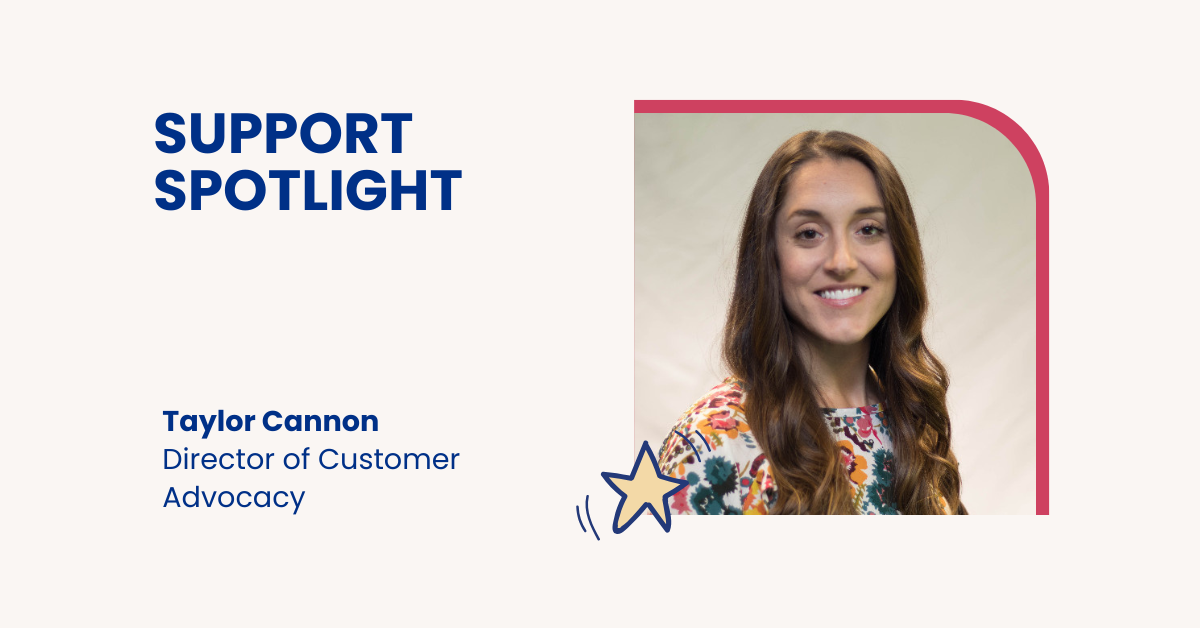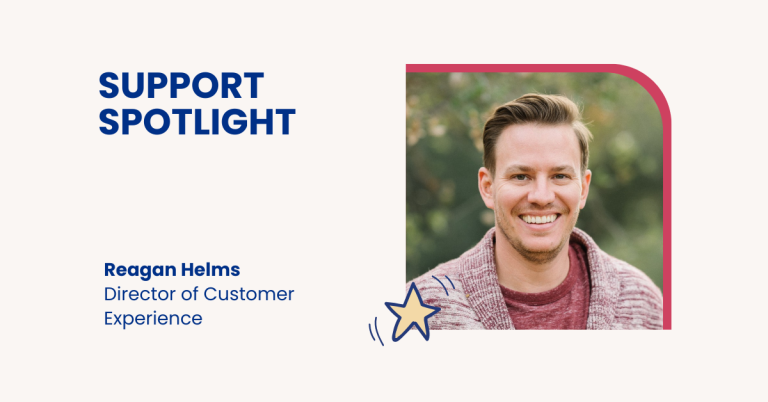The logistics industry is renowned for its fast-paced and complex operations and can provide valuable lessons and best practices for delivering exceptional customer experiences. In this interview, we delve into the valuable perspectives of Taylor Cannon on the importance of customer-centricity and the strategies that drive success in the logistics world and beyond.
Can you tell us about your journey? How did you end up working with CX?
My exposure to customer success and CX started back in 2018 when I was working at UPS. At that time, customer experience was a new concept for our organization. I was part of a team of four people, pioneering the concept of customer experience within our entity at UPS.
Our team’s sole focus was on improving customer experience within our organization. We worked on various initiatives and efforts to enhance CX in different areas of the company. Although concepts like CX, NPS, and Agile methodology were new to me, I grew to love working on them through our team’s accomplishments. Within a year and a half, we made significant improvements using Agile methodology and a small team.
Evangelizing the concept of customer experience and its importance became our mission. We aimed to show how everyone, even if not directly interacting with customers, could impact their experience. These conversations and challenges shaped my understanding of customer experience while being new to the organization.
Last year, I took a leap of faith and left UPS to join my current organization. My primary challenge was kickstarting a voice-of-customer program. This involved learning about the new organization, selecting an experience management vendor, integrating the vendor platform, and establishing surveys and feedback loops across different business units. It was an intense period of establishing the importance and significance of these initiatives to various teams.
What does your day-to-day work look like in your current role?
This year our focus is to maintain the feedback loop programs we’ve established and involve more business units in our voice of customer program. Our main goal now is to emphasize and spread the customer-centric mentality throughout the organization.
On a typical day, my responsibilities include managing the distribution of surveys for different business units across the organization. I follow up with leadership in each business unit regarding feedback loop efforts, initiatives, and the insights we receive related to themes, trends, and pain points. Collaboration with other teams is crucial, particularly in terms of educating them about the voice of the customer program and conducting training sessions.
Additionally, I prioritize my own continuous education to stay updated on the latest developments in the field of customer experience. Keeping up with industry trends and best practices allows me to represent that knowledge and engage in meaningful conversations with my internal teams.
In your opinion, what are the biggest challenges for CX nowadays that you see in your work but that other companies and other CX leaders might also be facing?
One of the significant challenges I’ve encountered is navigating the different silos within our organization. This is a common issue that has been acknowledged by other CX groups I’m involved with. Breaking down these business unit silos has proven to be quite challenging, especially given the nature of our business and the structure of our organization.
Due to multiple mergers and acquisitions, our organization is like a puzzle with many pieces. It has been a struggle to create structured programs that can effectively work across all types of business units. This has created roadblocks and hindered the efficient utilization of our customer information and operational data.
A particular frustration arises from the difficulty in aligning the valuable customer data and sentiment information we receive from our vendor. Unfortunately, our vendor has not been integrated into our internal systems due to internal issues. As a result, a lot of manual work is required, including manual data uploading and contact management. We don’t have real-time data access and are dependent on the last uploaded information.
The combination of business unit silos and the lack of effective use of customer information and operations data poses significant challenges that need to be addressed to improve our overall CX efforts.
Why do you think it is so hard to drive change and make the voice of customer heard? Why are organizations so resistant to change from a CX point of view?
There are several challenges that I believe contribute to the difficulties we face in managing customer experience (CX) effectively. One significant piece of the puzzle is the lack of education and knowledge surrounding CX, both among internal stakeholders and business leaders.
When I first embarked on my journey with CX at UPS, I encountered resistance from internal stakeholders who struggled to grasp the concept and differentiate it from customer service. This lack of knowledge extends to business leaders, especially at the C-suite and executive level, who play a crucial role in making financial decisions. If they don’t understand or buy into the importance of CX and the voice of the customer, it becomes challenging to secure the necessary resources for our initiatives.
Education, therefore, emerges as a crucial aspect of addressing these challenges. Another obstacle I’ve noticed is the lack of immediate return on investment (ROI) for business leaders. CX initiatives require time and sustained effort to yield significant changes. One survey or a round of qualitative responses won’t bring about instant transformations. This becomes particularly challenging in a slower economy like 2023, where cost-cutting is a priority.
Furthermore, there’s a lack of resources and company investment in CX, which ties back to the difficulty in gaining buy-in from employees. This lack of employee engagement is directly connected to the earlier-mentioned education gap. When employees don’t understand the “why” and the importance of CX, it becomes an uphill battle, as they are the ones interacting with clients and customers, crucial for building long-term relationships.
Even minor actions, such as being rude to a customer or failing to follow up promptly, can have a multiplied negative effect on the change management efforts we’re trying to implement. These challenges highlight the interconnected nature of education, resource allocation, employee buy-in, and the need for immediate ROI to drive effective CX management.
How does technology help you daily in your work? And what do you see as the trends in technology specifically for your function in CX?
When we selected our current solution, the reasons were its position as a top player in the industry and its potential for growth. We initially started small, focusing on core experience management such as survey sending and feedback loops. However, what excited me was the possibility of expanding and using other more advanced CX features.
I envisioned the ability to connect external feedback with how our employees and internal stakeholders feel, allowing us to make necessary changes, provide training and coaching, and drive improvements. This internal transformation would then reflect in the experience we offer to our clients.
Our current solution provides me insights into the voice of the customer, customer loyalty, and how we are perceived based on the surveys we send out. As we roll out self-service options to our clients, I hope to gather feedback on their experiences and strategically align it with our overall strategy. This creates a feedback loop environment where insights from both external and internal sources contribute to our continuous improvement efforts.
What advice would you give to someone just starting their career in customer experience?
My advice is to embrace that initial excitement. It’s important not to get overwhelmed by the vast amount of work that needs to be done. Starting small and focusing on the basics is key. It’s crucial to educate yourself continuously, stay up to date with the latest trends, and understand key concepts, like net promoter score (NPS) and customer satisfaction (CSAT).
Remember, this is still a relatively new concept, and it can be tempting to compare yourself to others who seem far ahead. But each company is unique, and what works for others may not work for yours. Give yourself some grace and understand that progress takes time, especially in organizations with thousands of people.
Stay focused on the ultimate goal and keep your eye on the prize. Show the importance of CX and the return on investment (ROI) over time. If you can get buy-in from your business leaders and executive teams early on, it will alleviate the pressure of proving yourself constantly. Celebrate your wins and share them with others in the organization. This will not only ignite more excitement within yourself but also inspire others to join the journey.
How do you see your department’s role in relation to your company’s goals for the next five years?
I believe there will be a greater focus on customer experience, voice of the customer, and the importance of long-term customer relationships. In my company, there has already been positive progress in these areas. Moving away from short-term relationships to prioritizing long-term customer satisfaction will ultimately lead to more financial success for the organization.
I feel fortunate that our President truly believes in the Net Promoter Score (NPS) and understands that it goes beyond just those three letters. NPS encompasses a broader scope, and I can see the organization’s knowledge and recognition of the importance of overall customer experience and customer satisfaction grow.
As we continue to emphasize the value and return on investment (ROI) that comes with focusing on these aspects, I envision opportunities for team growth. Although I currently have one direct report, I foresee the potential for expansion as we demonstrate the significance of our work and its positive impact on the organization.
Specifically for our company, as our objective is customer and carrier satisfaction in the logistics industry, there is a strong alignment and support for the efforts I’m undertaking. By emphasizing and showcasing the ROI we achieve through these initiatives, we can gain more support and resources for our ongoing work.
To wrap up, what are you looking forward to regarding the future of CX?
I believe there is still so much more to come in the immediate years and even in the next 5 to 10 years. Personally, I am most excited about the technological advancements in customer experience.
Currently, our organization is in the early stages, and much of the work I do is manual. However, I anticipate that with team growth and increased knowledge, we will have more individuals to support these initiatives. This will enable us to fully leverage the analysis tools and resources provided by our software provider, allowing us to be more real-time in our actions and feedback loop. Ultimately, I hope that our customers and clients will recognize the efforts we put into these areas and become loyal returning customers.
In the supply chain world, where interactions are often transactional, it is crucial to emphasize long-term relationships. As the logistics industry evolves, especially post-COVID, we need to prioritize building these lasting connections. While my perspective may be specific to logistics, I am optimistic that there is still so much untapped potential and room for growth in our approach to customer experience. We have only scratched the surface of what is possible.

Taylor Cannon
Taylor Cannon is an accomplished professional currently serving as the Director of Customer Advocacy at Transportation Insight. With a strong background in customer-focused roles, she has made significant contributions throughout her career. Taylor’s experience includes managing digital solutions at UPS, where she provided consulting and insights to customers and led implementation efforts. She also played a key role in enhancing customer experience and streamlining processes. With a diverse background in account management, customer service, and international cultural exchange, Taylor brings a unique perspective to her role.
Did you like the post?
You might also like:

Surveypal
Everything you need to lead and improve your customer experience. Learn more at surveypal.com, or






